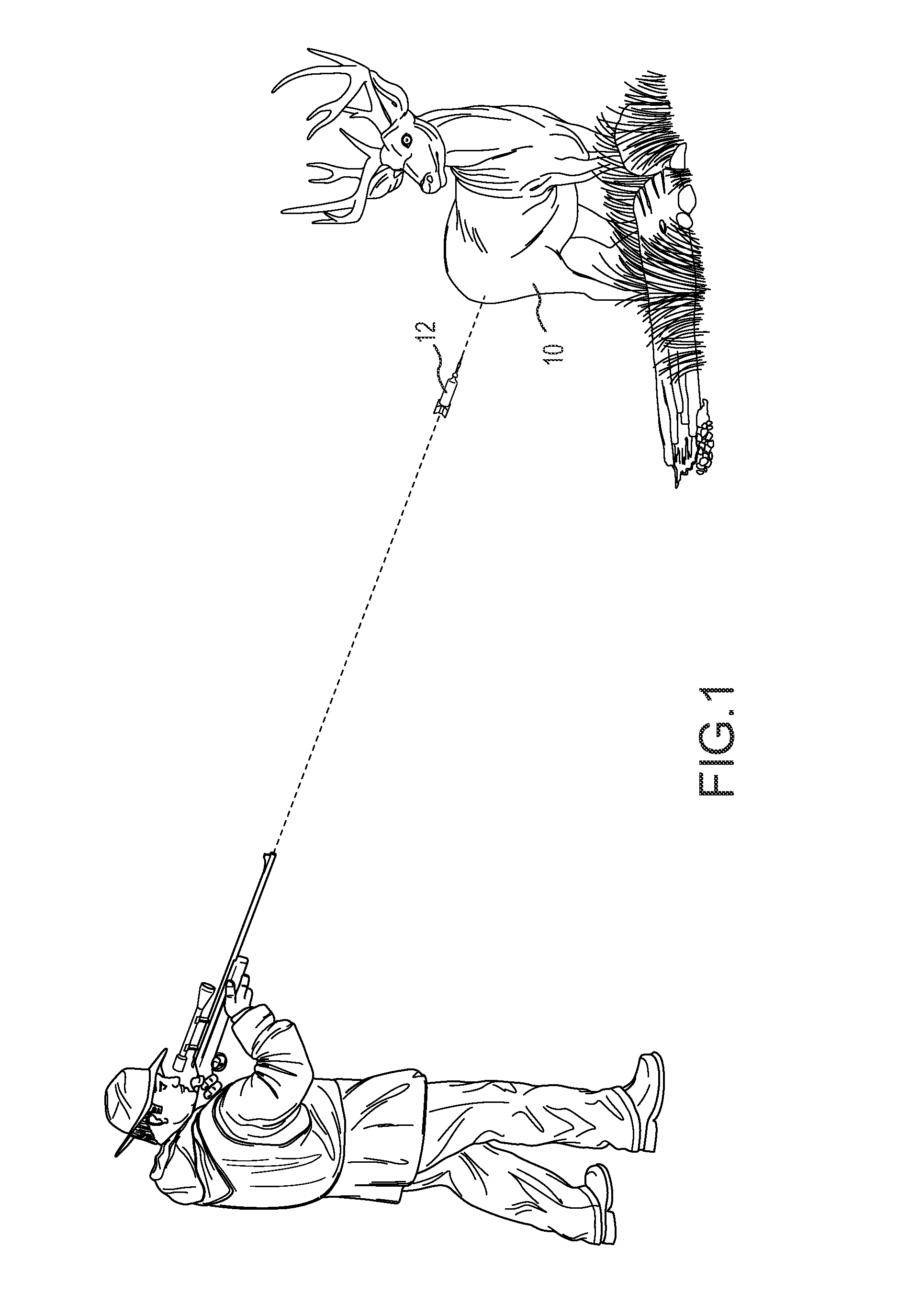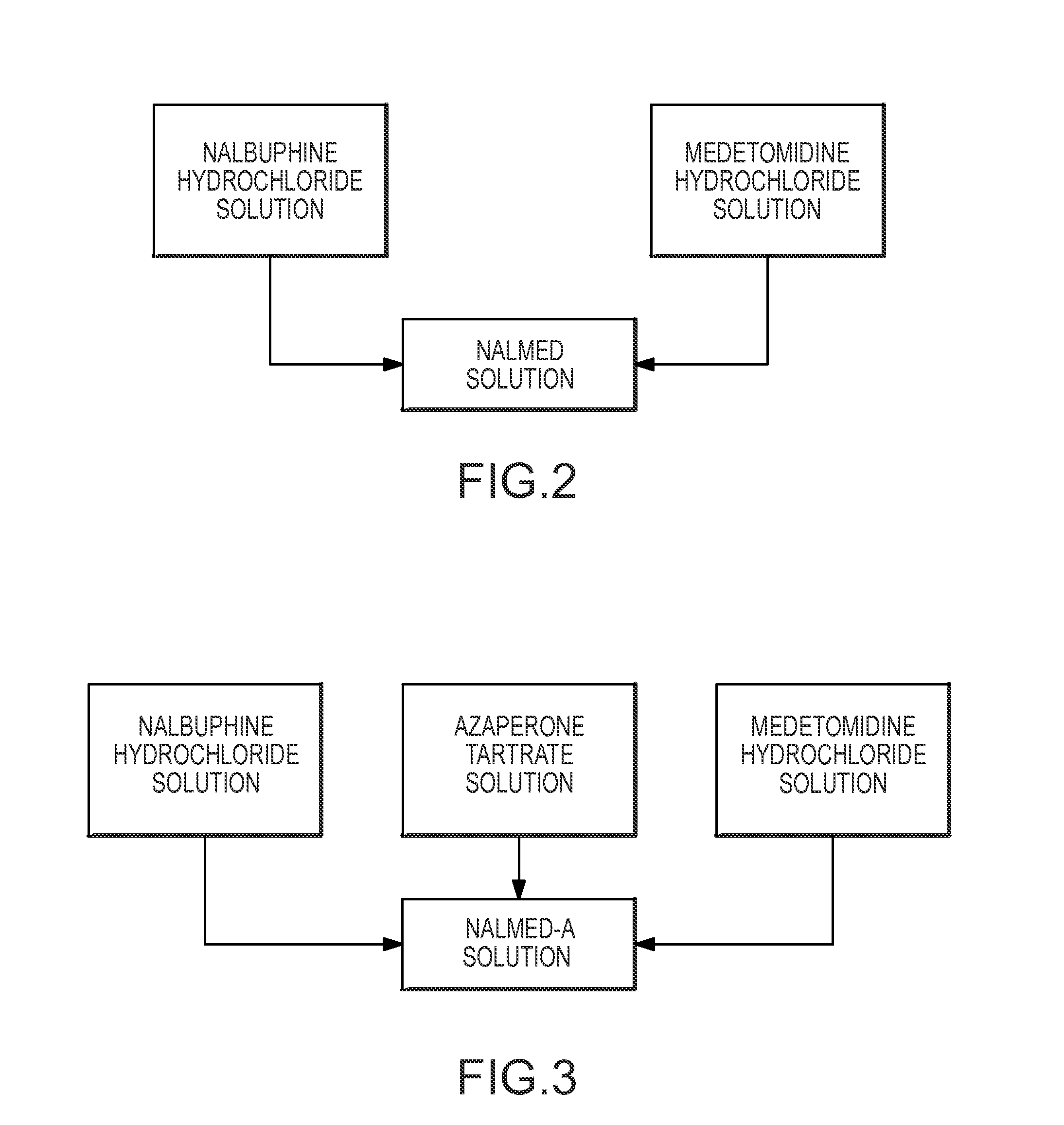Sedating and Immobilizing Non-Domesticated Mammals
- Summary
- Abstract
- Description
- Claims
- Application Information
AI Technical Summary
Benefits of technology
Problems solved by technology
Method used
Image
Examples
example 1
[0039]NalMed and NalMed-A were first tested on adult Rocky Mountain elk (Cervus elaphus nelsoni). A nalbuphine hydrochloride dosage of about 0.3 mg / kg was used in both NalMed and NalMed-A. NalMed and NalMed-A were both effective in immobilizing the adult elk. NalMed (40 mg / ml nalbuphine hydrochloride and 10 mg / ml medetomidine hydrochloride) was dosed at 1.8-2.0 ml, and NalMed-A (40 mg / ml nalbuphine hydrochloride, 10 mg / ml azaperone tartrate and 10 mg / ml medetomidine hydrochloride) was dosed at 1.8-2.0 ml. Dose volumes that included about 80 mg nalbuphine hydrochloride tended to yield shortest inductions. A mean induction time of 6.8 min occurred with NalMed-A, and a mean induction time of 7.7 minutes occurred with NalMed.
[0040]For recovery, 50 mg naltrexone hydrochloride and 600 mg tolazoline hydrochloride were administered intramuscularly (IM) about 5 min in advance of 100 mg atipamezole hydrochloride (divided 25 mg intravenously [IV] and 75 mg IM). Administration in this manner pr...
example 2
[0042]Five bighorn sheep (Ovis canadensis) under fenced management were successfully immobilized by the administration of NalMed. The five sheep had an average weight of 72.2 kg. Each animal received 1 ml of NalMed. The 1 ml dose contained 40 mg nalbuphine hydrochloride and 10 mg medetomidine hydrochloride. The average dose rate was 0.55 mg / kg of nalbuphine hydrochloride and 0.14 mg / kg medetomidine hydrochloride. The average time to first effect was 4.8 minutes. The average time to safe approach was 9 minutes.
[0043]Sedation was reversed with a combination of atipamezole hydrochloride, tolazoline hydrochloride, and naltrexone hydrochloride, as in Example 1. All animals completely recovered to standing in 8 to 16 minutes. Significantly, no supplemental oxygen was required, since all of these animals maintained oxygen saturation levels above 79%.
example 3
[0044]Eight white-tailed deer (Odocoileus virginiansus) in a fenced enclosure under management were administered NalMed-A by remote injection dart. Six of the eight deer were 8 months of age and two were adults over 2 years in age. The average estimated body weight of the eight deer was 28 kg, but individually the deer ranged from 15.5 kg to 44.4 kg in weight. The six 8-month-old deer each received 0.5 ml of NalMed-A containing 30 mg nalbuphine hydrochloride, 10 mg azaperone tartrate, and 10 mg medetomidine hydrochloride per ml. The two adult deer received 1 ml of the same formulation. The average dose rate for the 8 month old deer, which averaged 22.6 kg in body weight, was 0.66 mg / kg nalbuphine hydrochloride, 0.22 mg / kg azaperone tartrate and 0.22 mg / kg medetomidine hydrochloride. The dose rate for the two adults, which averaged 44.4 kg in body weight, was 0.66 mg / kg nalbuphine hydrochloride, 0.22 mg / kg azaperone tartrate and 0.22 mg / kg medetomidine hydrochloride.
[0045]All eight d...
PUM
| Property | Measurement | Unit |
|---|---|---|
| Weight | aaaaa | aaaaa |
| Density | aaaaa | aaaaa |
| Density | aaaaa | aaaaa |
Abstract
Description
Claims
Application Information
 Login to View More
Login to View More - R&D
- Intellectual Property
- Life Sciences
- Materials
- Tech Scout
- Unparalleled Data Quality
- Higher Quality Content
- 60% Fewer Hallucinations
Browse by: Latest US Patents, China's latest patents, Technical Efficacy Thesaurus, Application Domain, Technology Topic, Popular Technical Reports.
© 2025 PatSnap. All rights reserved.Legal|Privacy policy|Modern Slavery Act Transparency Statement|Sitemap|About US| Contact US: help@patsnap.com


